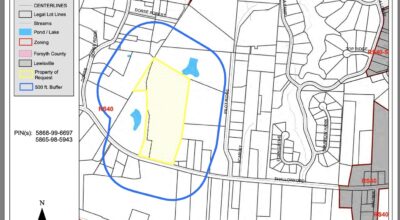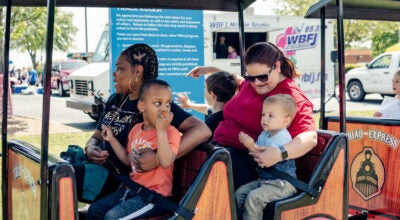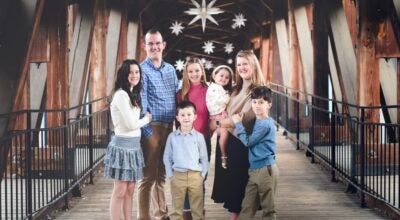Your Neighbor: Learning the rules: Amy Lawrence masters the art of teaching dyslexic students
Published 12:00 am Thursday, March 7, 2019
Sometimes, there are neighbors in our community who have greatness hidden behind their humbleness. Amy Lawrence is one of them. She is a teacher at Summit School and there is so much more to Amy than meets the eye.
Rewind back a few years to Amy’s childhood. Her life began to take shape in the small town of Lumberton where the population is just now over 21,000. It’s where Amy acquired her genuine and charming, long southern drawl. As the youngest of six children, Amy’s personality was also influenced by her place in her big family. “It was a hoot because I was the caboose. In a big family, you learn a lot of people skills,” notes Amy. “You learn firsthand what it is like to work together. You are just one part of the equation. You are not the whole domain. Everyone has their own personalities and there is teamwork.” Amy says it was through her parents that she learned to have passion for any task she set out to conquer. “I think that’s why I love teaching so much. My parents instilled in me a never-give-up attitude.” As Amy’s life progressed, that can-do philosophy would be necessary for her to achieve her goals.
As a young girl, reading was a daily struggle. Not surprisingly, the odds of becoming a teacher did not seem great for Amy. “Teaching school was the furthest from my mind. I wanted to do something in science because my parents were scientists.” At the age of 10, Amy was tested and diagnosed as being dyslexic. Through hard work, Amy overcame the challenges that can come with dyslexia.
As Amy came to learn, dyslexia is not necessarily just a reading issue or even a visual recognition challenge. Rather, it has more to do with the way the brain processes information. People may not realize it, but students diagnosed with dyslexia typically have an IQ that is average or, more often, higher than average. In fact, dyslexia is often suspected when a child is capable of learning at a higher level than is currently being reflected in his or her school work. Some of the fallout from not knowing that dyslexia is at the root of lackluster grades can be frustration and a loss of self-confidence for the student, and in some cases, for teachers as well. Traditional approaches to learning can be ineffective. Thus, unless dyslexia has been identified, teachers trained to teach in traditional ways may not have the tools with which to help the dyslexic child and may not even recognize it. As one might imagine, early detection presents the opportunity for dyslexic students to more quickly reach a greater academic potential through learning methods more appropriate for their situation.
For the dyslexic student, thoroughly memorizing the rules of the English language can be a gateway to their future success. For example, they are taught to remember that the vowel before the letter ‘k’ in words such cake, take and bake will be long. However, if the word contains the combination of ‘ck,’ then the vowel is short, as is the case in words such as trick, crack, and back. Thus, when students come across unfamiliar words, they need only refer back to the prevailing rules.
In Amy’s case, she has come to learn just how important these rules can be. During her senior year of college at Ferrum, Amy decided she wanted to teach children. After college, she worked in private schools in Virginia, Vermont, South Carolina, and North Carolina. “By that time, I had become involved with the Orton Dyslexia Society. I received training from Dr. Lucia Karnes who worked with June Orton at the Orton Reading Center at Salem College.” The Orton-Gillingham method was developed to teach dyslexic children how to read using rules. The benefits of this method were clearly near and dear to Amy’s own heart. Amy’s childhood lessons in teamwork were also on her mind when she went on to serve as president of the International Dyslexia Association in the South Carolina branch and the North Carolina branch, while she continued teaching and training.
With Amy’s extensive work, it seemed apropos when she was asked to submit an application to the Academy of Orton-Gillingham Practitioners and Educators (AOGPE). Only a select few would be taught in New York in 1994. It was the first year the academy opened and they only wanted the best of the best. After three years of teaching and attending the academy’s rigorous program, Amy was awarded her fellow. Becoming a fellow was commensurate with receiving a doctorate in dyslexic education. “It was a day filled with jubilation. This whole OG community seems to be a close community, so when you get a fellow or you get certified or an associate level, there is a celebration. It is quite a major feat.”
In 2014, Amy was asked to join the board of AOGPE, a tremendous honor. The small number of select members are scattered throughout the United States. She serves as chair of the programs committee, is on the accreditation committee, and is also secretary. With all of her knowledge, Amy has decided to extend her education even more. This summer, she will begin her master’s program at Appalachian University. “I could be signing my death certificate, but I am going back to school instead,” she laughs. “I am a life-long learner and I would just like to continue on down the journey, even though I am quite older than the regular collegiate person.” Amy says her desire to continue to learn stretches outside of the classroom as well. She has become an avid fly fisherwoman. “When I turned a certain age, I decided I was going to treat myself and take lessons.” Amy smiles again and jokes, “I decided I was going to do it because I love the colorful preppy clothes they wear. But it does create a lot of relaxation and mindfulness.”
Amy says her most favorite way to spend her time is in the classroom. “The best thing about teaching is the company I keep. I really enjoy the children. I believe when you are helping children read and spell, it is like going to the Super Bowl every day. You see them make gains and you see them make touchdowns. You see the self-esteem growing and there is nothing else like that in the world.” Perhaps nothing in the world compares to the huge impact our neighbor has upon these highly intelligent children. Because of Amy, these kids will not fall through the cracks. They can now live up to their potential and become the future engineers, teachers, and doctors that makes our society a prosperous community, just as Amy has.




